edible SAN DIEGO





























F r o m r e c i p e s t o r i t u a l s , t h e S p e c i a l t y P r o d u c e A p p s e r v e s u p a t a s t e o f t r a d i t i o n s f r o m a r o u n d t h e w o r l d , t a k i n g y o u r t a s t e b u d s o n h o l i d a y t r a v e l a s y o u i n d u l g e i n t h e r i c h h i s t o r y a n d h e r i t a g e o f f a r o f f f e s t i v e f a v o r i t e s .

B i t e i n t o t h e j u i c y h i s t o r y o f t h e N o r f o l k B e e f i n g a p p l e , a n E n g l i s h h e i r l o o m v a r i e t y m o s t n o t a b l y k n o w n f o r b e i n g s l o w c o o k e d , c o m p r e s s e d , c o o l e d , t h e n c o r e d t o m a k e a s o f t , c h e w y t r e at c a l l e d a B i f f i n T h e s u g a r c o a t e d d r i e d a p p l e s w e r e m a d e b y b a k e r s i n N o r f o l k , E n g l a n d , a n d w e r e s e n t t o t h e b u s t l i n g C h r i s t m a s m a r k e t s o f L o n d o n , c a r e f u l l y p a c k a g e d a n d s o l d a s a w i n t e r d e l i c a c y t h r o u g h o u t t h e V i c t o r i a n E r a .
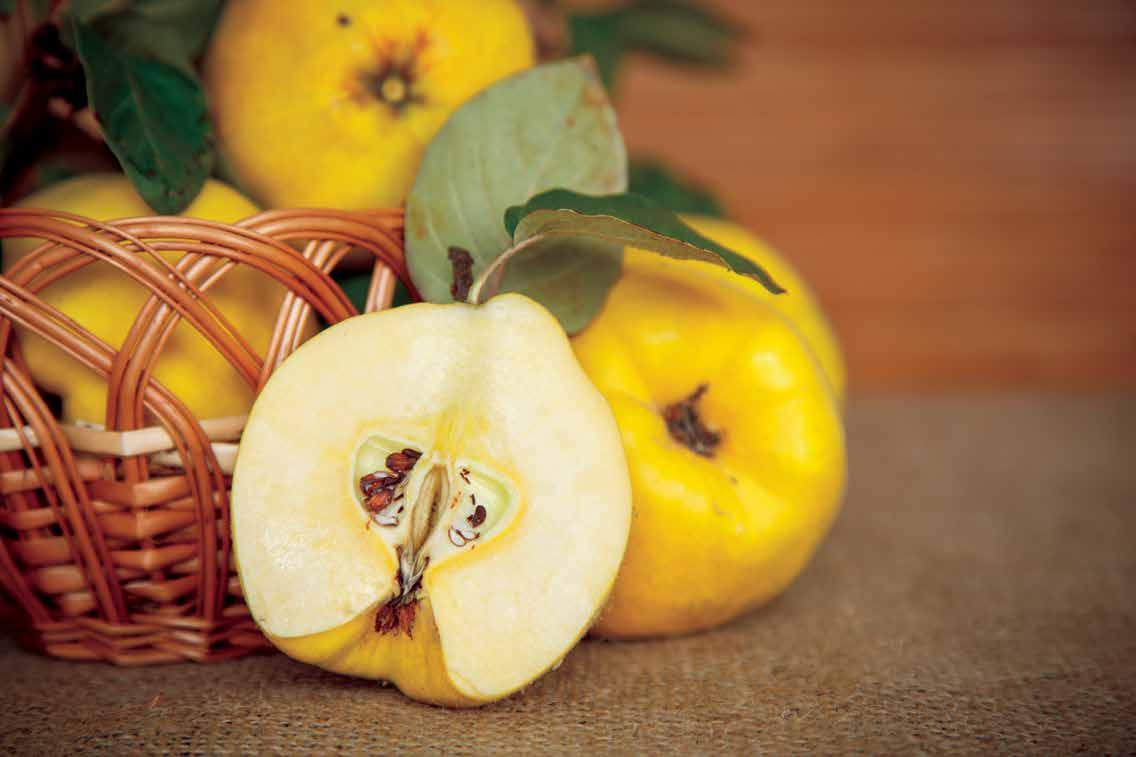
I n f a c t , B i f f i n s b e c a m e s o i n t e r t w i n e d i n L o n d o n ’ s h o l i d a y s e a s o n t h a t t h e y w e r e e v e n r e f e r e n c e d i n A C h r i s t m a s C a r o l b y C h a r l e s D i c k e n s , o n d i s p l a y a t t h e c o r e o f t h e n o v e l ' s h o l i d a y m a r k e t , “ e n t r e a t i n g a n d b e s e e c h i n g t o b e c a r r i e d h o m e i n p a p e r b a g s a n d e a t e n a f t e r d i n n e r . "

A n o t h e r f a v o r i t e f o o d o f C h r i s t m a s p a s t i n E n g l a n d i s q u i n c e p a s t e , o r q u i n c e c h e e s e , a f i r m , s l i c e a b l e f r u i t p a s t e w i t h a f l o r a l , h o n e y s w e e t f l a v o r t h a t w i l l t a k e y o u o n a t r i p d o w n m a r m a l a d e l a n e K n o w n a s m e m b r i l l o i n S p a i n a n d m a r m e l a d a i n P o r t u g a l , t h i s p r e d e c e s s o r t o t h e c o m m e r c i a l i z e d c i t r u s p r e s e r v e w a s m o l de d ( q u i t e l i t e r a l l y ) f r o m a h u m b l e a n c i e n t f r u i t c a l l e d q u i n c e , a s o u r b u t a r o m a t i c r e l a t i v e o f a p p l e s a n d p e a r s I n e d i b l e w h e n r a w , q u i n c e s w e r e t r a d i t i o n a l l y b o i l e d w i t h s u g a r a n d t h e n p o u r e d i n t o a m o l d t o s o l i d i f y T h e y w e r e o f t e n s h a p e d i n t o e l a b o r a t e d e s i g n s a s a s y m b o l o f s t a t u s , p e r h a p s b e c a u s e s u g a r w a s a n o t o r i o u s l y e x p e n s i v e c o m m o d i t y u n t i l t h e 1 7 t h c e n t u r y , t h o u g h q u i n c e d o e s h a v e a l o n g h i s t o r y of r e v e r e n c e i n E u r o p e i n i t s o w n r i g h t
T h i s h o l i d a y s e a s o n , w h y n o t r e v i v e o n e o f t h e s e o l d w o r l d r e c i p e s w i t h a f r e s h m o d e r n f l a r e u s i n g a p p l e s a n d q u i n c e f r o m t h e w i n t e r f r u i t w o n d e r l a n d a t o u r w a r e h o u s e ! C r a v i n g m o r e ? D o w n l o a d t h e S p e c i a l t y P r o d u c e A p p t o s a v o r t h e o f t e n w h i m s i c a l , s o m e t i m e s s t r a n g e , a l w a y s s a t i s f y i n g s t o r i e s o f t h e f r u i t s a n d v e g e t a b l e s t h a t k e e p u s c o z y t h r o u g h t h e w i n t e r a n d g a r n i s h o u r f e a s t s w i t h c h e e r !

I N A N O P E N F I R E
S C A N T O D E V O U R M O R E !
It’s winter. Make yourself something warm to drink, and let’s sit for a while.
Welcome to something unexpected. We have spent this entire year shifting to a regenerative mindset. This fall we considered people in the food system inspiring good change.
Where does this journey bring us this season? To a world we know very little about but which literally makes our lives possible. In this issue, we explore the microbiome in our bodies, living soils, and how they are connected.*
It makes sense when you stop to think about it, doesn’t it? Healthy soils enable nutrient-dense foods to grow. When more people eat nutrient-dense foods and channel resources out of a waste stream into fruitful use, the virtuous cycle can continue. Indeed, our wellness, energy, and ability to fend off disease reflect a delicate balance of factors invisible to the naked eye. Join us as we take an introductory look at these marvelous, mysterious processes under the ground and inside our bodies.

These “little things” are everywhere, so let’s meet some spontaneous beer, get the lowdown on kombucha, and try our hand at composting.
For some inspiration in the kitchen with helpers of all sizes, we
present Edible for Kids: Delicious Dumplings and a crossword puzzle to play with some of the terms you see on these pages.
As I look back over this year, I am very proud of our team. Maria Hesse, our executive editor, has been instrumental and such fun to work with as we charted a new editorial path and design style. We are so honored that the 2022 San Diego Press Club Awards recognized 13 examples of excellent work by our talented contributors. Thank you to every advertiser, member, subscriber, and reader. We are very excited to go deeper on stories about how eating can be a conscious, healing, inclusive act in our upcoming 15th anniversary year.
For now, though, in San Diego County’s mild wintry months, we hope you make time to rest and nourish yourself. May we discover that we are enough as we are and so very capable of making abundance the norm around the world.
Katie Stokes Publisher and Editor in Chief, Edible San Diego*Have you read Gut by Giulia Enders or Suzanne Simard’s Finding the Mother Tree? Have you seen Fantastic Fungi? I couldn’t recommend them more wholeheartedly.
For information about options, rates, and deadlines please contact katie@ediblesandiego.com.


No part of this publication may be used without written permission from the publisher. © 2022 All rights reserved. Every effort is made to avoid errors, misspellings, and omissions. If an error comes to your attention, please let us know and accept our sincere apologies.

This magazine is made possible thanks to Edible San Diego advertisers, members, and subscribers. Thank you for supporting San Diego’s local, independently owned food media company.

CONTACT
Edible San Diego
1501 San Elijo Rd. South #104-210 San Marcos, CA 92078 601-526-1919 info@ediblesandiego.com ediblesandiego.com



















Living soil is beautiful and vibrant, like an abstract painting of colors that flow and mix on a canvas. Below the surface, the living soil is a very busy place, able to support life and maintain its own ecosystem. Living soil is essential for gardens to feed the plants that ultimately feed us. Its layers and textures, when in balance, bring growth and nutrition to our lives.
Visualize earthy brown colors mixed on a palette and then brushed across a canvas. Some strokes are lighter and paler; other strokes are a lush olive color. These first few strokes of the painting begin to form the base layers and represent the radiant diversity of nonliving molecules called loam. Loam is the foundation of living soil. It is composed of three equal parts: sand, silt, and clay. The loam triangle plays a key role in contributing to structure, water retention, and, most importantly, nutrients and minerals.
Down the center of the painting, cocoa color abstract triangles repeat and represent balance and unity. Omitting one side of the loam triangle leads to imbalances. Dry sand or silty soil types are fine and lack structure, which can even repel water and become hydrophobic. Heavy clay soils often resemble bricks when they are dry and dense, or they can be lumpy and sticky when wet. In the right ratio, clay, sand, and silt mixed with some organic matter can provide living soil with incredible nutrient resources and moisture retention.
Water is also vital. Harmonious blue colors flow with broad brushstrokes because without water, there is no life. Cool white, milky brushstrokes are reserved spaces for oxygen, essential to all life, which allows organic matter to begin decomposition and prevent compaction. With water and oxygen, the microorganisms wake up and begin the regenerative push and pull of nutrient cycling deep in the soil.
The textile weave begins to reveal itself as brushstrokes are pushed and pulled across the canvas. The warp and weft are barely noticeable, tiny, and insignificant, but they still play a major role. Their purpose is to hold the paint in place, creating lasting bonds. This is exactly what millions of microorganisms are
doing. Bacteria decompose organic matter, creating delicate glues and smaller bonds between soil particles. The fungi also help decompose organic matter and create longer bonds and larger soil structures. Eventually, the underground soil food web becomes a complex food chain. Bacteria and fungi are consumed by larger organisms like protozoa and nematodes, becoming something called humus. Humus is dark, rich decomposed organic matter loaded with plant-soluble nutrients and minerals. Burgundy lines wiggle through the layers of the painting. At last, larger-bodied organisms like red earthworms eat everything in their path including bacteria, fungi, protozoa, nematodes, and decomposing material. Their frass, or poop, is black gold. This is when the magic begins.
Swoops of soft pink illuminate the painting with feelings of joy, love, and support. The living soil has worked hard and offers many gifts to the plant. The plant accepts a steady stream of nutrients and minerals now accessible in a plant-soluble form through its roots. Only taking what it needs, the plant grows and makes a promise to return the favor. While the plant gains energy from photosynthesis, it sends a flowing substance down into the rhizosphere, or root zone, offering sugary foods and protection from pathogens returning the gesture. The painting lights up using linear shades of yellow, the color of friendship. This amazing cycle continues for infinity as long as all the colorful components are present. Living soil is truly incredible. s
Additional Resources
Fungi create longer bonds to build large soil structures.
Oxygen and organic matter prevent soil compaction.
Water is vital. Without water, there is no life.
Loam is the foundation of living soil.


Plants a c cept a steadystreamofsoluble nutrients and minerals found inhumus.
Plants send sugar y f o o ds and protectionfrom pathogens into the rhizosphere.
Stacey Messina is a talented artist and the owner of Seed & Trellis, San Diego Kitchen Gardens. She offers virtual garden designs and personal coaching services for gardeners all over the nation. She is passionate about organic and regenerative practices using bokashi and composting to elevate garden experiences. Learn how to grow food beautifully at seedandtrellis.com or follow @seedandtrellis on Instagram. To see more of her artwork, visit staceydmessina.com.



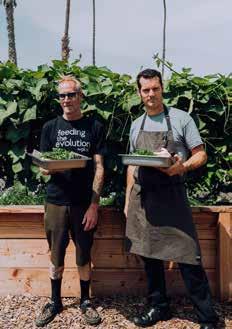


Spencer Rudolph has lived in the unincorporated area north of Escondido since 1999. He’s intimately acquainted with the three acres at his family’s Sage Hill Ranch Gardens since he “crawled all over it” as a child when there were few residents beyond North Broadway. Now, he and his sister Paige, plus three other people, grow and sell organic greens, herbs, and flowers there using regenerative practices. “We’d rather generate than degrade,” he says. The farm is organic and sustainable, using compost they’ve made from cassia and clover, plus fungi, without any tilling.
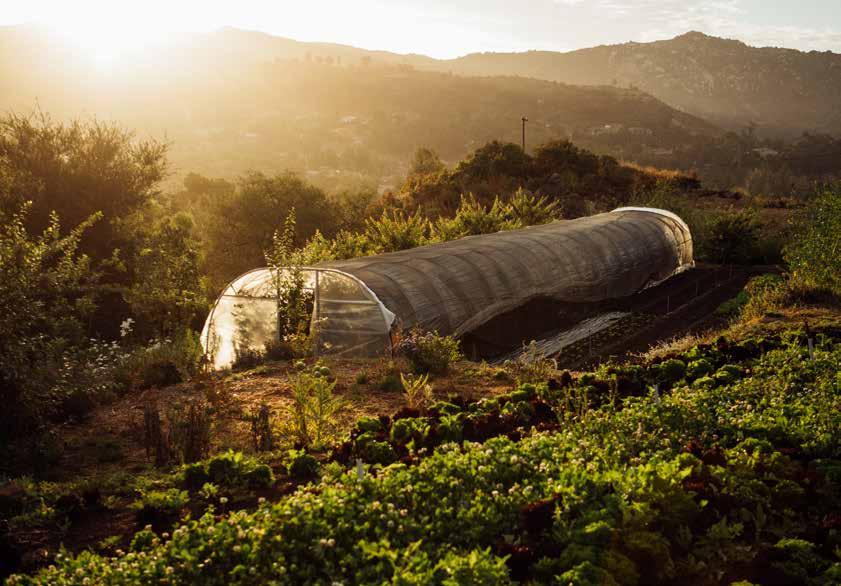
Large farming businesses routinely plow plants back into the land to form a flat surface on which to plant new crops, but this extraction from the earth without replenishing it causes 10% of our greenhouse gas emissions, according to the Natural Resources Defense Council. Rudolph passionately tells us that it destroys aggregates—pathways for water and organisms to carry nutrients to plants. His analogy: “Imagine if you had your entire house turned upside down every 60 days.” He says tilling can damage crops by adding oxygen to the soil, thereby burning up organic
matter and pulling carbon out of the earth into the atmosphere, which contributes to climate change.
The dark, crumbly soil beneath his feet is home to earthworms that enjoy living near the ginger plants in a “tunnel,” where lettuces and bacteria maximize the use of sunlight and heat. “Farming for us is all about bacteria, how it moves, how to make it healthier, and thereby make people healthier,” Rudolph says. Worm poop, or castings, are rich in nutrients for plants.
Outside, under avocado trees, Rudolph bends down and scoops away leaves to reveal mycelium, the woody substrate that supports wine cap mushrooms above ground. Mycelia can filter toxins and decompose organic matter, converting it into nutrients for plants around them. “Mushrooms are a sign that the soil is in good health in general,” Rudolph says.
Healthy soil is defined by “the capacity to operate as a living system of diverse organisms, which combat plant disease and pests and combat climate change by maintaining or increasing its carbon content,” according to the Food and Agriculture
Earthworm castings are a great natural fertilizer.
 MARIA HESSE
MARIA HESSE
Organization of the United Nations. Living soils also have a greater capacity to hold moisture and transfer it to plant roots. Rudolph observes his crops closely for any imbalances, such as pest infestations, and adjusts his practices accordingly. It’s easier for plants to fight off pests and disease if they are in good shape, just as humans can more easily fight off disease when in prime condition. Our own health relies on healthy soils and clean water passing along vital nutrients to plants in our diet. This, along with exercise, can help us avoid serious illnesses faced by a majority of Americans, according to the US Department of Agriculture.
Plants prefer rain over irrigation or runoff, and their leaves and stems perk up afterward. Rudolph collects rainwater in a tank when possible and irrigates from his public water supply. Using rainwater helps reduce exposure to pollutants—such as pesticides, fertilizers, oil, and trash—that can encroach on land via runoff from streets and other properties, according to San Diego County Water Authority. Chemicals infiltrating soil or on our food can have negative health impacts if consumed throughout our lives, especially in the smaller, less mature bodies of children. The Environmental Protection Agency has a wealth of information on the subject. (epa.gov)
Buying food from local companies enables us to learn more about how the produce grows. Sage Hill Ranch Gardens sells its produce at a farmstand onsite on Saturdays during select seasons

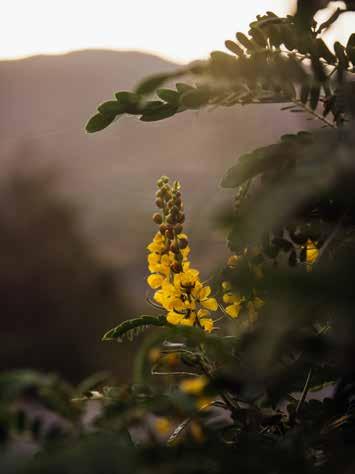

Arts
» juliantea.com
2124 Third St. 760-765-0832
Afternoon tea and lunch service plus gift shop with 500+ teas, teapots and teaware, tea making tools, children’s tea sets, linens, books, cards, housewares, and much more!
Julian Candy Basket
» thejuliancandybasket.com
2116 Main St., Upstairs 760-765-0785

We specialize in nostalgic candies. We also have plush, mugs and lunch boxes and more.
Jeremy’s on the Hill
» jeremysonthehill.com

4354 Hwy. 78 760-765-1587
Fresh, seasonal, organic, healthy, local and outstanding cuisine. Our philoso phy behind California cuisine is to keep it fresh, keep it simple, and keep it tasting great.

Julian Hard Cider LLC
» julianhardcider.biz
4470 Hwy. 78 760-703-7307
Our tasting room currently has 12 ciders on tap, with 4 rotating handles of unique, Julian-only specialty ciders produced at our small production facility @ Apple Lane Orchard.
The Cooler

@julianbeercooler
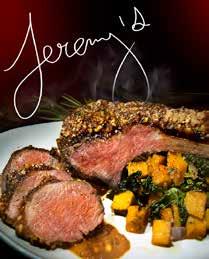


4466 Hwy. 78 760-315-3411
Preeminent destination for local artisan beer, hard cider, and specialty mocktails.
Heroes » julianheroes.com
4355 Hwy. 78 760-765-1004
Nothing brings us together like good food... and live music. Join us for a memorable time in a comfortable friendly setting.
Soups and Such Café

2000 Main St., Ste 101 760-765-4761
Wholesome food, beautiful flowers.
Fort Cross Old Timey Adventures » fortcross.com
4425 Hwy. 78
Family owned and operated adventure farm with hands-on activities. Big focus on historical education, outdoor adventuring, agritourism, music, art, and FUN!
Above: Wine cap mushroom mycelia are planted between avocado trees and greens. The mycorrhizal activity helps to bring nutrients to the root systems. Top right: A passion fruit vine grows over a rainwater collection tank at Sage Hill Ranch Gardens. Bottom right: Ginger and lettuces growing in a tunnel.
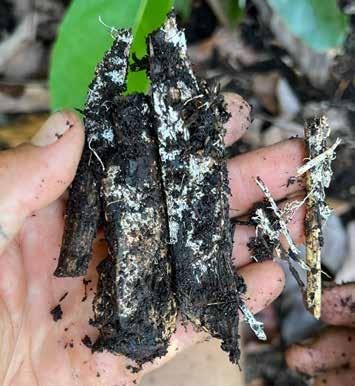

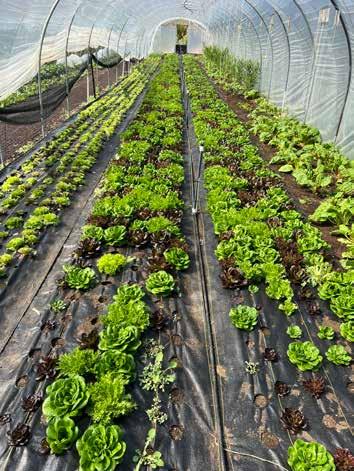
and welcomes the public on scheduled tours and for special events.
One person educating San Diegans about vegetables, fruit, and spices traditionally used to achieve optimal health is chef Lan Thai, aka Chef Lando, of Cardiff. Born in a refugee camp in Thailand to parents fleeing the communist takeover of Vietnam, Thai has a rich Southeast Asian culinary heritage and has added to that through her travels. She grew up on a family farm in Lakeside, where she often had her hands in the soil. Years later, when her mother was given only two months to live due to cancer, Thai kicked into high gear by studying natural healing; she soon began offering her mom ginger and other herbs to ease the side effects of chemotherapy. She also gave her a cannabis tincture to help her get off pain medication. Her mother lived another two years, she said in a San Diego Union-Tribune article. Thai’s 19-acre farm in Bonsall isn’t open to the public, but she inspires and nourishes people at Enclave Café locations in La Jolla and Torrey Hills. Her vision to help people around the globe learn the ancient knowledge of Food As Medicine (FAM) has earned her recognition from San Diego County’s Board of Supervisors.
In her video podcast The FAM Show, Thai offers a blend of history with culinary and wellness tips as she chops, stirs, and pours into steaming pots and bowls. She uses fresh ingredients,

including turmeric, moringa, fenugreek, and cardamom. Moringa, she says, is also known as the “miracle tree.” “It’s like spinach and tastes 10 times better than kale. All parts of the plant can be eaten.” Moringa is drought-resistant and available year-round in many parts of the globe, “making it one of the most sustainable edible crops in the world. Africans have called it ‘never die’ because it’s the only thing that grows in the dry season and they’ve even called it ‘mother’s milk.’” (Scientific studies of moringa can be found online via the National Library of Medicine.)
The expression “We are what we eat” continues to take on a deeper meaning. Research is unveiling the exquisite way that tiny organisms in our gastrointestinal tract operate like one organ, passing important information to all parts of our bodies. Keeping these healthy gut microbes happy is key to our health.
Research shows that if we wipe them out by taking too many antibiotics, drinking too much alcohol, or simply not feeding them what they want, there can be negative consequences. Highly processed food, plus stress and environmental factors, can also alter gut microbes and has been linked to anxiety, autism, obesity, heart disease, diabetes, arthritis, irritable bowel syndrome, Alzheimer’s, and cancer. Conversely, scientists believe it’s possible that through understanding the specific role microbes play in our daily lives, we can harness them to treat diseases, including depression, mental illness, and insomnia.
So, how do we support the microbes in our gut that support our healtht? In general, studies show they prefer a diverse, plant-rich diet. The more we increase the variety of produce in our diets, the greater the potential benefits. Microbiomes are nourished by soluble fiber (found in grains, nuts, seeds, and legumes), plus prebiotics from vegetables and fruit. Probiotics, whether in supplement form, fermented foods (e.g., kimchi), or cultured products (e.g., yogurt), also play a positive role.
University of California San Diego is leading in gut microbiome research. Professors Jack Gilbert and Rob Knight direct their own labs as part of the school’s Center for Microbiome Innovation and cofounded the American Gut Project, which grew into The Microsetta Initiative, to collect and analyze gut microbiome samples from members of the public, dubbed “citizen scientists.” Participating allows researchers to explore how diet, lifestyle, and the environment can collectively change our microbiomes.
Not only do healthy soils, water, food, and air directly impact personal health, but we impact the environment around us— with how and what we eat and how we dispose of food and packaging. Education is key, as is simply getting back to nature more often. Growing our own food and mingling with neighbors and vegetable shoppers, plus cooking healthy recipes, all have their own benefits, like reducing stress and developing important social connections and support networks. Even putting our hands in soil releases a hormone that is proven to improve depression, support immune systems, and a lot more, according to research. Relaxing in a park or forest has also been shown to decrease stress responses.
— Spencer Rudolph, Sage Hill Ranch Gardens
Meanwhile, farmers also need a reprieve from their work after the harvest is over. Spencer Rudolph and his wife Missy will take a break from opening the farmstand over winter to spend more time with their baby. One day soon, she’ll be walking all over the farm too, as the cycle of life, soil, and harvesting continues.
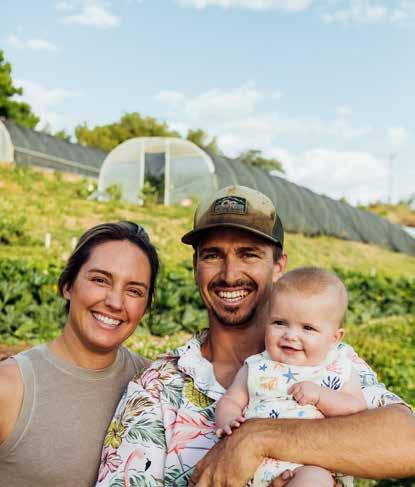
***This article is not intended to provide nutritional advice. Consult your health practitioner before making any changes, especially if you are on a special diet. Even natural products can have side effects if used incorrectly or in conjunction with pharmaceutical products. s
Sage Hill Gardens Ranch
610 Calle Ricardo, Escondido
Farmstand open seasonally on Sat, 9am Also at the Poway and Leucadia farmers’ markets
» sagehillranchgardens.squarespace.com
Enclave Café
4655 Executive Dr., La Jolla 3570 Carmel Mountain Rd., San Diego
» adventuroussuperfood.com
“Farming is all about the bacteria, how it moves, how to make it healthier, and thereby make people healthier.”
KEEP
BOX SIZE: Aim for at least 3x3’ .
Items that should not be added to your compost pile include:
• ashes (affects pH balance of the soil)
• meat (causes odor, attracts pests)
• fish and fish bones
• whole eggs (egg shells are okay)
• animal fats or other oily products
• dairy products
• cat litter
• dog or cat feces
There’s no better way to fortify your garden while reducing your contribution to landfills, but starting a compost pile can feel a little daunting. Just remember to follow this simple equation:
Nitrogen-rich items make up the “greens” part of your pile.
GREENS INCLUDE:
• fruit peels, seeds and cores
• vegetable peels and seeds
• green leaves
• grass clippings
Use a pitchfork or shovel to turn the pile once a week or so, to aerate and help distribute moisture content. Gaps between the boards also help oxygen circulate.
Items that produce carbon are called “browns,” and should make up the bulk of your pile (aim for three parts brown to one part green).
BROWNS INCLUDE:
• twigs and branches
• dry leaves
• sawdust
• hay or straw
• mulch or wood chips
• old topsoil
• animal manure (from vegetarian animals ONLY—no cat or dog feces)
START WITH A THICK BASE LAYER of brown material, including sticks, twigs, wood chips, hay or straw to promote air circulation. Then alternate layers of greens and browns, making sure to always have a layer of browns on top, to balance the moisture. Add water as needed to keep the pile damp but not wet—the moisture content should be like a wrung-out dishrag. Too dry? Add some water or greens. Too wet? Add more browns.
HARVEST! The compost is ready to use after 2 3 months. Once the pile is ready, you can also add worms to speed the process up.
TIGHT ON SPACE? A smaller compost pile can be successful with the addition of red wiggler worms. Fill a box 8 16” deep with layers of soil, newspaper and leaves. Place the worms on top with a layer of fruit and vegetable waste. Be sure to make holes in the bottom of the box to allow for ventilation and drainage.


Pure Project Brewing’s Lief, an American gueuze, features the purest sense of terroir a beer can possess
 BY BRANDON HERNÁNDEZ
BY BRANDON HERNÁNDEZ
There are numerous ways to infuse a sense of place into a beer. Common methods include the use of locally grown hops, incorporation of indigenous fruit, and aging in second-use barrels from nearby wineries and distilleries. While these practices produce regionally distinct flavors, nothing matches the ultimate expression of terroir presented by spontaneous beer.
Originating in Belgium, where it is referred to as lambic, spontaneous beer is produced in a much different manner from traditional ales and lagers. Rather than use a prescribed yeast strain and meticulously shield unfermented beer from outside elements, lambic producers invite wild yeast and bacteria to exclusively ferment their beers in open-fermentation vessels which allow naturally occurring microorganisms to become part of the process. The inoculated beer is then funneled into oak barrels to age for months, or often years, where it develops funky flavors and aromas often described as “barnyard” or “horse blanket.” Those characteristics are distinctly unique to the solitary spot in which the lambic was produced and cannot be replicated anywhere else.
From day one, spontaneous beer has been at the forefront for Pure Project Brewing, where cofounding brewmaster Winslow Sawyer has succeeded in honoring old-world tradition while providing an authentic, multifaceted expression of San Diego in a glass. His vehicle for both is Lief, a blend of one-, two-, and three-year-old spontaneous beers. Such blends are called gueuzes in Belgium, but Sawyer refers to Lief by the process behind it.
“Lief is a méthode traditionnelle three-year blend brewed using the historical process used to brew gueuze in Belgium,” says Sawyer. “A lambic-based beer—turbid-mashed local grains with a significant amount of aged hops—is spontaneously fermented and then aged for one, two, or three years before blending and bottle conditioning. We only use a portion of each year’s vintage so we can continue to package Lief year after year instead of just once every three years.”
Sawyer and his team collected wild yeast for their first two
Left: A stainless steel tote in the bed of a pickup truck carries wort to be cooled in the Cuyamaca air.
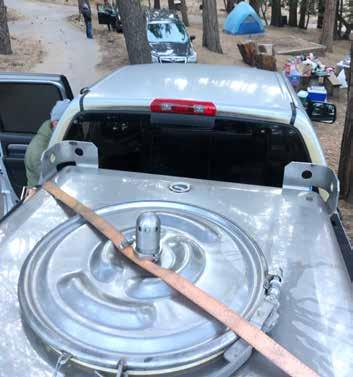

State Park.


lambics at Cuyamaca Rancho State Park and Mount Laguna, respectively, while year three’s unfermented beer was left uncovered at Pure Project’s brewery in Miramar during the company’s three-year anniversary festival. The resultant beer was spritzy from secondary fermentation in the bottle and marked by aromas of hay and Asian pear, gooseberry tartness, and a lasting, earthy funk.
Pure Project is one of only three local breweries (The Lost Abbey and Burning Beard Brewing are the others) to have taken on the laborious process of crafting a gueuze, and the brewery has continued to expand on its spontaneous beer program with a number of specialty creations.
The Vista-based company (which also operates tasting rooms in Carlsbad, Miramar, North Park, and Bankers Hill) recently released a raspberry-and-cherrylaced homage to Belgian krieks and framboises called Electric Depths and has a Euphorik series of American lambics that have been infused with strawberries, cherries, blueberries, and black currants over the years. The fruits from the latter are given a second life through Pure Project’s Deja Fruit line of farmhouse ales, also known as saisons.
Lief and its familial offspring are labors of love, but also love letters to the county that played an integral role in birthing them. s
» purebrewing.org



Get to know the SCOBY and other kombucha basics
 BY CHRISTINA KANTZAVELOS
BY CHRISTINA KANTZAVELOS
Welcome to the world of kombucha!
Kombucha is a fermented tea drink and an amazing source of probiotics that aid in good gut health. While there are two basic types of kombucha drinks, alcoholic and nonalcoholic, we’re talking about the nonalcoholic version here.
How is kombucha made?
Kombucha is made by adding strains of yeast and bacteria, along with sugar (or honey), to green or black tea and allowing it to ferment for more than a week. The probiotics in kombucha come from the SCOBY, an acronym for “symbiotic culture of bacteria and yeast.”
What is a SCOBY?
A probiotic colony is one of the most beneficial components of drinking kombucha. The SCOBY is cellulose—plant fiber— that contains the beneficial bacteria and yeast cultures that turn sweet tea into kombucha. A new SCOBY, also known as a baby SCOBY, is made with each new batch of kombucha. Like sourdough bread, kombucha has a starter. You need a batch of SCOBY if you’re interested in making your own kombucha at home. The SCOBY can also be eaten, freeze-dried, or added to a dish.
Kombucha offers an outstanding balance of acidic, fragrant, and fruity flavors. Depending on what flavor you purchase, as well as the type of tea, sugar, or honey used, don’t expect it to be sugary sweet or overly spiced. It’s different from your standard sodas or energy drinks, although some kombucha brewers have started creating cola-like flavors that make it a much healthier alternative.
The fermentation process gives kombucha its natural fizz. A combination of acids, which lend to its vinegary smell, and sometimes its sour taste, mixed with the other ingredients in kombucha also adds to the carbonation.
What are the health benefits of kombucha?
Although newer to the United States, kombucha has been
consumed in Asia for its taste and health benefits for thousands of years.
Kombucha contains antioxidants that can kill harmful bacteria in your digestive tract and perhaps even help fight disease. The fermented tea is also rich in prebiotics and probiotics, which are essential for gut health and keeping your immune system functioning correctly.
Additionally, drinking kombucha may aid in digestion, body inflammation, and even weight loss. When kombucha is made from green tea, it contains several bioactive compounds, such as polyphenols, which are potent antioxidants in the body and can take out free radicals that can damage your body’s cells. Studies have found that drinking green tea daily can increase caloric metabolism, reduce body fat, improve cholesterol, and help with blood sugar levels. Drinking green tea has also shown a reduced risk of prostate, breast, and colon cancers.
Research supports that drinking kombucha regularly may reduce toxicity to the liver caused by environmental chemicals, and many believe it can help relieve symptoms associated with chronic health problems. It’s also a simply refreshing beverage.
Try these local kombuchas:
TapShack Kombucha features real fruits and superfoods in their raw kombucha.
» drinktapshack.com
Babe Kombucha is handcrafted with local ingredients.
» babekombucha.com
Howling Moon Kombucha offers truly unique combinations of flavors like the Tuk Tuk Tea with coconut, lemongrass, and lime.
» drinkhowlingmoon.com











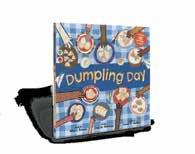
Try your hand at cooking savory dumplings with this recipe for traditional Russian pelmeni.
• Put the ground meat, onion, salt and pepper into a large bowl and mix.
3. Assemble the pelmeni:
• Take out the dough and divide it into two large balls.
• Roll out one ball into a log, about 2 inches in diameter.
• Cut off a section about 1 inch long and roll it into a ball.

• Fill a large pot halfway with water and add a pinch of salt.
• Turn on the stove to mediumhigh heat and bring the water to a boil.
• Add a handful of pelmeni to the pot.
Illustration and text adapted from Dumpling Day (Barefoot Books), written by Meera Sriram and illustrated by Inés de Antuñano. Recipe by Laurel P. Jackson
1. Make the dough:

• Mix the flour and salt in a large mixing bowl.
• Crack the eggs into the bowl and mix everything together.
• Pour in the water and mix with your hands, kneading until you have a smooth and elastic dough.
• Cover the bowl with a damp towel. Set aside.
• Use a rolling pin or your fingers to flatten the ball into a thin circle, 2–3 inches in diameter.

• Place 1 tsp of filling into the middle of the circle.
• Fold over the circle to create a halfmoon and pinch the edges together with your fingers to seal. Join the two corners towards the middle and pinch again to seal.
• Sprinkle flour over the pelmeni and place it onto a clean surface. Repeat until all pelmeni are assembled.
Makes: about 48 pelmeni • Time: 1½ hours • Serves: 6 people
• Cook for about 3–5 minutes, until the pelmeni float to the top. Check to make sure the meat has cooked all the way through! They might need a few extra minutes.
• Take out the pelmeni and place them onto a serving plate.
• Serve with melted butter and sour cream for a filling meal.
is created in partnership with indie, award-winning, Concord, MA-based children’s publisher, Barefoot Books. Learn more by visiting www.barefootbooks.com
• Wash and peel the potatoes. Slice each potato into 6 pieces and place them in a large pot.
• Fill the pot with cold water, just enough to cover the potatoes.
• Turn on the stove to medium heat and cook the potatoes for about 15 minutes, until they are tender (easy to pierce with a fork).
• Place the cooked potatoes in a large bowl and let them cool. Then mash with a fork or potato masher.
• Stir in the peas, curry powder, ginger, cumin, coriander, garlic salt and garam masala.
• Take out one puff pastry sheet. With a knife, cut out a circle that uses most of the pastry. Then fold the circle in half.
• Dip your finger into a bowl of water and gently moisten the edges of the half circle.
• Fold the half circle over to make a triangular shape. Pinch the moistened edges together to make a cone.
• Fill the cone ¾ of the way with filling.
• Pinch the open side of the dough to close the cone. Use a moistened finger to make sure that the edges are all sealed.
• Repeat until all the samosas are made.
• Heat the vegetable oil in a frying pan on medium heat.
• Place 3 or 4 samosas at a time into the frying pan. Fry for about 2 minutes on each side, then flip. Repeat until both sides are golden brown.

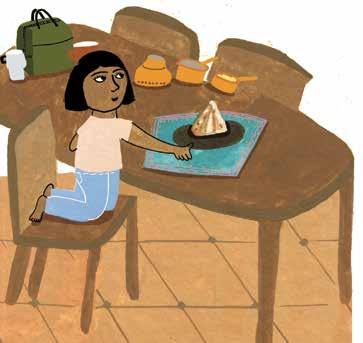

• Put the fried samosas on a plate lined with paper towels to drain off extra oil.
• Serve alone or with chutney, as a side dish or snack.


People all around the world make different-shaped dumplings with a wide variety of spices and ingredients. Some are eaten before a meal or as part of a main course, while others are enjoyed for dessert.














Many of these dumplings come from regions of the world, not just single places. For example, shish barak are enjoyed in several Middle Eastern countries including Syria, and people cook fufu throughout West Africa.
is created in partnership with indie, award-winning, Concord, MA-based children’s publisher, Barefoot Books. Learn more by visiting www.barefootbooks.com.


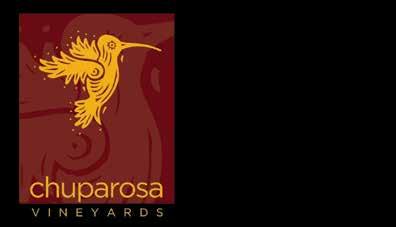






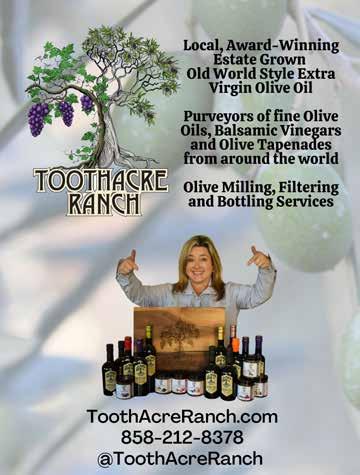
Our bodies are independent communities of microorganisms, each one completely unique from the other. Colonies of bacteria, fungi, and viruses live on our skin and within our bodies. In fact, there are more of these microorganisms than there are human cells in the body and the relationship is symbiotic, and even codependent. This is the human microbiome.
Many of these microbes live in the mucosal lining of the colon and are directly connected to the immune system. Scientific studies reveal that a diverse range of beneficial foods can improve immune function.
All of this might seem overwhelming, but one of the very practical things we can do to improve our health is to eat different things, from day to day, week to week, season to season.
Lion’s mane mushrooms like these from Golden Mushroom Co. are considered medicinal and offer both digestive and nootropic benefits.

Eat a diverse array of whole foods (unrefined and without artificial ingredients) and lots of fiber-rich plants. Basically, eat as many vegetables and fruits as you can.
Prebiotic
Fiber promotes growth of beneficial bifidobacteria* linked to improving immune system health.
Edible mushrooms are an excellent source of prebiotics, which nourish beneficial gut bacteria. While all edible mushroom varieties serve as rich dietary sources of fiber and plant-based protein, try varieties like shiitake, oyster, and lion’s mane for the most gut-boosting benefits.
Probiotic
*bifidobacteria (plural) are found in the intestinal flora of humans and produce acetic and lactic acid by fermenting carbohydrates.
Sourdough fermentation offers both prebiotic and probiotic benefits to eaters. Most commercial sourdough breads are made with instant yeast and artificial flavors. If you’re not up for baking it on your own, it’s best to buy from a reputable supplier that uses a natural sourdough starter.
Cook’s Gluten-Free Sourdough
» cooksglutenfreesourdough.com
Izola Artisan Bakery
» izolabakery.com
Jane’s Baking Co.
» hotplate.com/janesbakingco
Knockout Bread
» sienna1702.aidaform.com/ko
Olive Baking Company
» olivebakingcompany.com
Prager Brothers
» pragerbrothers.com
San Diego Urban Farm
» sdurbanfarm.com
Sourdough Delight
» sourdoughdelight.com
Wildwood Flour
» wildwoodflour.com
Below: Homemade sourdough starter. Right: Peppers fermenting in jars.
Enjoy fermented foods rich in lactobacilli (probiotics) like kimchi, tempeh, kefir, yogurt, sauerkraut, and miso.
Learn to make your own fermented foods with the San Diego Fermenters Club


» fermentersclub.com
Down to Ferment
» down2ferment.com
Edible Alchemy
» ediblealchemysd.com
San Diego Tempeh
» sandiegotempeh.com
Twins Kimchi
» twinskimchi.com
West Coast Koji
» westcoastkoji.com
Chanterelles have never been successfully cultivated—they are found only in the wild.
They are native to northern Europe, North America, Asia, and Africa.
In the 1700s in France, chanterelles were served to nobility and became a much-sought-after delicacy. Chanterelles are one of the richest sources of naturally-occurring Vitamin D available.
Shown here is the wild variety; cultivated versions have longer, slender stems with tiny caps and are pure white— a result of being grown in an environment high in CO2 and not exposed to light. Most enokitake found in supermarkets have been grown inside a plastic bottle.
Wild enokitake are extremely hardy, often growing in snowy environments, they can freeze solid, then continue growing once thawed!
The word maitake means “dancing mushroom” in Japanese.
Oyster mushrooms were first cultivated in Germany during World War I.

Not only do they look like shucked oysters (hence the name), some are said to taste similar to oysters as well.
Nematodes beware: the oyster mushroom is carnivorous—it can kill and digest you!
The name shiitake is Japanese for shii (the type of tree that these mushrooms typically grow on) and take (mushroom).
The earliest record of shiitake cultivation is during the Southern Song Dynasty in Japan in 1209. They are a symbol of longevity in Asia, believed to have been used medicinally by the Chinese for more than 6000 years.
Commonly known as hen-of-thewoods (not to be confused with chicken-of-the-woods, which is a different type of mushroom).
The most mature variety of the same mushroom as the button (youngest) and crimini (more mature than the button but less than 4 inches tall with an un-opened cap), the portobello is grown until its cap fully opens.
One portobello mushroom contains more potassium than a banana!
They can grow very large, up to 6 feet in diameter and weighing up to 100 pounds!
Maitake grows in clusters at the base of trees, most often oaks, and grows in the same place for a number of years.
A younger version of the portobello.










Get out in the open air and shop for fresh seasonal produce and San Diego’s finest seafood. This guide to regional farmers’ markets includes listings for San Diego County and the City of Temecula.
Escondido—Welk Resort √† 8860 Lawrence Welk Dr.
Coronado √ 1st St. & B Ave., Ferry Landing
Escondido √* 262 E. Grand Ave.
Mira Mesa √* 10510 Reagan Rd.
People’s Produce Food Sharing Day— Mt. Hope NEW 4269 Market St.
Otay Ranch—Chula Vista √ 2015 Birch Rd. and Eastlake Blvd.
Pacific Beach Tuesday à 901 Hornblend St.
San Marcos √ 251 North City Dr.
Temecula—Vail Headquarters √* 32115 Temecula Pkwy.
UCSD Town Square √ UCSD Campus, Town Square
Little Italy Wednesday Mercato √*† 501 W. Date St.
Ocean Beach √ 4900 block of Newport Ave.
People’s Produce Mobile Farmers’ Market—Mt. Hope NEW 4269 Market St.
Santee *† Carlton Hills Blvd. & Mast Blvd.
South Bay √ 4475 Bonita Rd.
State Street in Carlsbad Village √ State St. & Carlsbad Village Dr.
Temecula—Promenade √* 40820 Winchester Rd. by Macy’s
People’s Produce Mobile Farmers’ Market—Lemon Grove NEW 2885 Lemon Grove Ave.
Linda Vista √*† 6939 Linda Vista Rd.
North Park Thursday √*† 2900 North Park Way at 30th
Oceanside Morning √* 401 Pier View Way & Hwy. 101
Rancho Bernardo √ 16535 Via Esprillo
Scripps Ranch √ 10045 Carroll Canyon Rd.
Friday
Borrego Springs √ 700 Palm Canyon Dr.
Imperial Beach √*† 10 Evergreen Ave.
La Mesa Village √* La Mesa Blvd. btwn Palm & 4th St.
Rancho Bernardo √ 13330 Paseo del Verano Norte
People’s Produce Mobile Farmers’ Market—Second Chance Garden NEW 6145 Imperial Ave.
Farmers’ markets shown in gray are temporarily closed. All listings are subject to change. Please contact markets directly to confirm hours of operation and locations. Visit ediblesandiego.com for more complete information and links to market websites.
City Heights √*†! Wightman St. btwn Fairmount & 43rd St.
Del Mar √ 1050 Camino Del Mar Fallbrook Main Street √ Main Ave. btwn Hawthorne and Fig.
Little Italy Mercato à 600 W. Date St.
Mission Valley à 7960 Civita Blvd.
Poway √* 14134 Midland Rd.
Rancho Penasquitos 9400 Fairgrove Ln.
Temecula—Old Town √* Sixth & Front St.
Tuna Harbor Dockside Market 598 Harbor Ln.
Vista √*† 325 S. Melrose Dr.
Sunday
Chula Vista √* 300 Park Way & Third Ave. Hillcrest √* 3960 Normal St.
La Jolla Open Aire √ 7335 Girard Ave. & Genter Leucadia √* 185 Union St. & Vulcan St.
People’s Produce Mobile Farmers’ Market—Machete Brewery NEW 2325 Highland Ave.
Murrieta √* 24480 Village Walk Plaza
Rancho Santa Fe—Del Rayo Village √ 16079 San Dieguito Rd.
Santa Ysabel √ 21887 Washington St.
Solana Beach √ 410 S. Cedros Ave.
* Market vendors accept WIC (Women, Infants, Children) Farmers’ Market checks.
Market vendors accept EBT (Electronic Benefit Transfer).

Market vendors accept WIC Fruit and Vegetable checks.
Markets certified by the San Diego County Agricultural Commissioner, ensuring that the produce is grown by the seller or another certified farmer in California, and meets all state quality standards. Temecula markets and the Murrieta market are certified by the Riverside County Agricultural Commissioner.





An age-old dance between plants and insects makes a biodiverse world go ‘round
BY SHARON REEVE, UCCE MASTER GARDENER OF SAN DIEGO COUNTY
Plants are anchored in one spot, but they are cunning. They have mastered the art of enticing more mobile organisms to do their bidding. It is the goal of every living thing to procreate and to live on through their offspring. Plants are no exception. There are many pollination strategies employed by plants. Wind pollination is highly inefficient, and self-pollination does not allow for evolution, so many plant species have evolved to entice and use insects and animals to pollinate themselves. One of the strategies used by plants to lure pollinators is to supply nutritious, high-protein pollen in the hopes that some of the pollen is not eaten but taken to other plants for pollination. Many plants also produce sweet nectar to lure in animals. Everyone loves sweets, as do insects, animals, and birds. Plants make sweet nectar to attract visitors to their flowers with the ultimate goal of the visitors accidentally carrying male pollen to the female stigma of another plant of the same species. Some orchids even go so far as to create structures that look like female bees to attract male bees. Male bees fooled by these look-alikes will attempt to copulate with them, and, in doing so, will spread the pollen of the orchid. This trickery is a cost-saving measure in that the orchid does not have to manufacture nectar or prodigious amounts of expensive pollen. While bees are the main pollinator of plants, there are other organisms that augment pollination, namely butterflies, hummingbirds, flies, wasps, bats, and beetles. Here, we focus on butterflies, flies, and bats.
Butterflies are the flashy members of the order Lepidoptera. Many of them have evolved to use highly toxic plants as caterpillar host plants to keep from being eaten. Bright colors also advertise sexual fitness, serve as camouflage, or mimic other more toxic butterflies. In the animal kingdom, orange is the color of danger and is frequently employed by butterflies. Dark wing colors act as solar collectors to warm the butterfly on cold days. Butterflies can see in the UV light spectrum. The pigmented scales that make up the wing can also look very different under UV light. Plants frequently have markings only visible in the UV spectrum that advertise the location of nectar and pollen. Butterflies use their long, coiled proboscis (mouthpiece) like a straw to sip nectar. Plants with wide, flat flowers like California native buckwheats (Eriogonum sp.) are choice nectar plants for many butterflies.
Top: A common buckeye rests on a native penstemon and absorbs solar radiation through its dark-colored wings. Bottom: A giant swallowtail butterfly nectaring on the easily accessible flowers of Crassula falcata, or propeller plant.

We think of pollination occurring during the day, but there are a number of organisms that pollinate only at night. Bats and moths take over when the sun goes down. In the dark of night, color and scent become incredibly important, which is why bat-pollinated plants bloom primarily white and are very sweetly scented. Bats are effective pollinators as they are able to transport large amounts of pollen on their furry bodies. Plants have evolved to hang away from the plant to give easier access to incoming bats. In plants like agave, pollen and nectar structures are prominently displayed along the huge flowering structure the plant makes before it dies. Agaves only bloom once, and when they do, they grow a bloom spike that is several times larger than the plant, sometimes as high as 15 feet. This is a massive investment of energy and the final chapter in this plant’s life. Agave tequilana (the source of tequila) pollen is especially nutritious and 50% protein, while the nectar keeps bats flying with 22% sugar.
Not only do plants produce nectar for pollinators, they can also create scents that are irresistible for their pollinator of choice. For example, flies feed on carrion, and plants in the genus Stapelia bloom accompanied by the stench of rotten meat. It isn’t really rotten meat, only the plant that has refined the scent of its flowers to attract large quantities of flies to pollinate. I have many species of Stapelia in my garden and when they bloom they attract a steady influx of flies. This strategy to attract flies is not limited to only the genus Stapelia as other members in the family Araceae do this. In fact, the aptly named skunk cabbage has the ability to raise the temperature of its flowers to make them smellier while it is blooming.


While plants look demure and defenseless, they are actually mighty and clever, with marvelous and wondrous ways to assure pollination. s
» mastergardenersd.org
Join the local food movement by patronizing the outstanding businesses that support Edible San Diego in producing award-winning stories, recipes, and videos about healthy living in San Diego County.
Kris Schlesser, owner
“
Edible San Diego is the voice of our local good food community. There are other media outlets that cover food in general, but LuckyBolt aligns more with Edible’s narrative. We advertise with them not just to reach their viewers, but to support the local community. It’s sort of like they’re the NPR of good food and we have to do our part so they can keep doing the work that they do.”
CHUPAROSA VINEYARDS
ROSE’S TASTING ROOM
SAFARI COFFEE ROASTERS SCENIC VALLEY RANCH VINEYARD SOLAR RAIN BOTTLED WATER WOOF ’N ROSE WINERY
DESTINATIONS
BERNARDO WINERY
SEE MONTEREY VISIT JULIAN
FARMS, FARMERS’ MARKETS & PRODUCE DELIVERY
FALLBROOK FARMERS’ MARKET
J.R. ORGANICS
LEUCADIA 101 MAINSTREET FARMERS’ MARKET
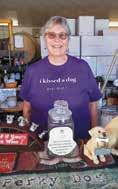
MAINSTREET OCEANSIDE FARMERS’ MARKET SAND N’ STRAW COMMUNITY FARM
GROCERY, MEAT & SEAFOOD
CATALINA OFFSHORE PRODUCTS
CORK & KNIFE
DA-LE RANCH
Coral Strong, owner
“I believe advertising with Edible San Diego lends itself to further connecting with the people that truly believe in the local food system that I support wholeheartedly.”

“We love Edible San Diego because it supports the local farm-to-table businesses that keep our county so special. Love the articles and recipes too.”
GOLDEN DOOR COUNTRY STORE GRUYÈRE CHEESE NIMAN RANCH
PERENNIAL PASTURES
SPECIALTY PRODUCE SPICEBREEZE TOOTHACRE RANCH
HOME, GARDENING, FLORISTS & RANCH SUPPLY GRANGETTO’S FARM & GARDEN
LIFESTYLE
COLLINS & COUPE EARTH DŌ REVESSEL
VINCENT RIPOL PERSONAL TRAINER
A.R. VALENTIEN BELLAMY’S
DI CICCO’S
THE FISH MARKET

GARDEN KITCHEN GIAOLA
LUCKYBOLT
MILLPORT
MITCH’S SEAFOOD NICK & G’S
Our readers are dedicated to supporting businesses that align with their values. Connect with them by becoming an advertiser or magazine distribution partner today. Scan the QR code or contact katie@ediblesandiego.com.

OCEANA COASTAL KITCHEN THE PLOT
SOLARE
AMERICAN FARMLAND TRUST
EPIK WORK
HARVEST JOY
MATT YUNKER, REALTOR
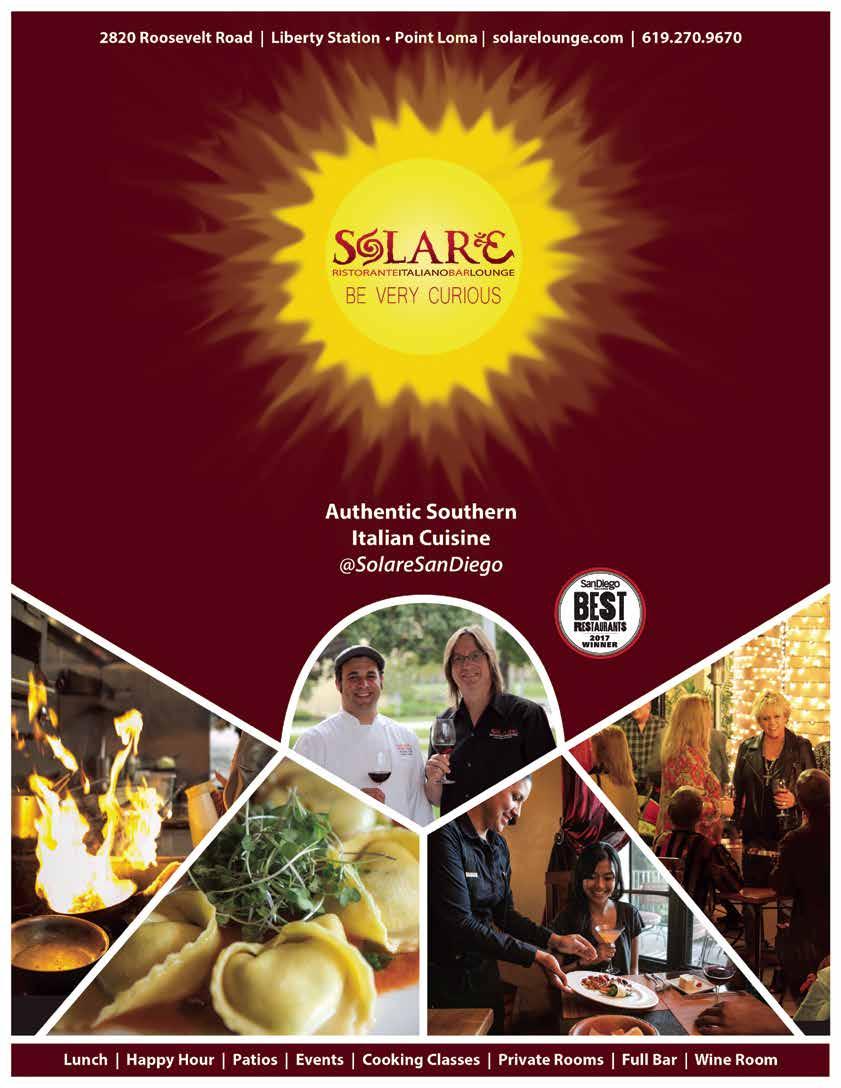

Get fresh updates on our work to ensure the future of agriculture includes all Americans.
farmland.org
Discrimination against marginalized groups in agriculture negatively affects all Americans by limiting the opportunities for farmers, workers, and consumers.
AFT is raising up diverse voices in agriculture, because we believe diversity contributes to a more resilient agricultural system, a stronger economy, and a more equitable society.
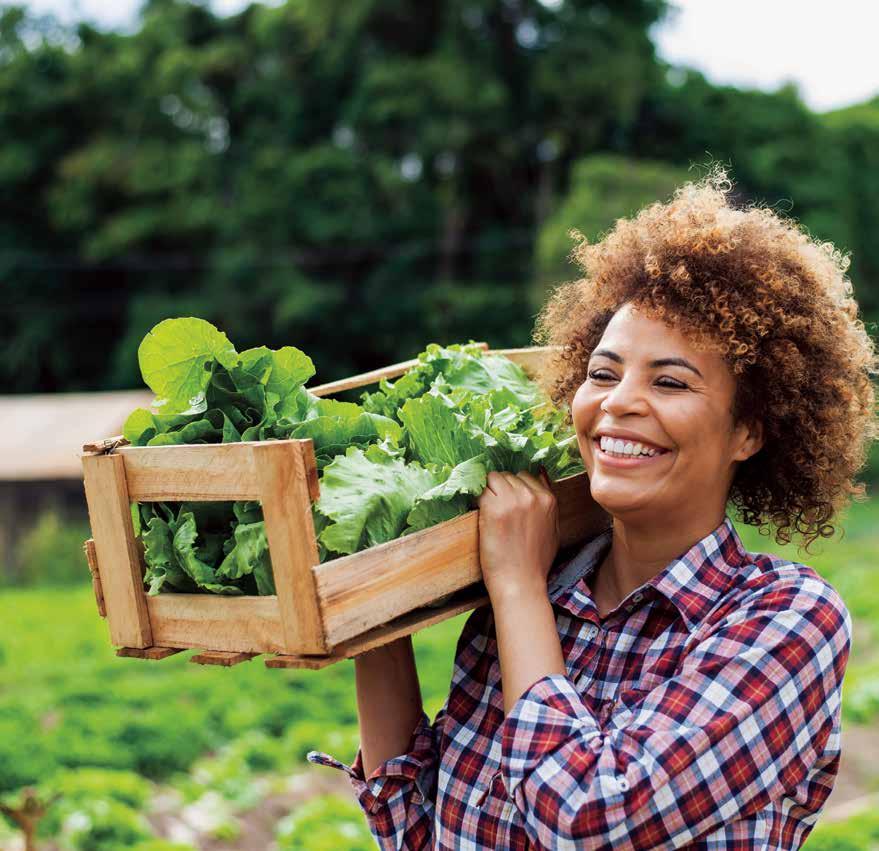
At American Farmland Trust, we believe agriculture is strengthened through diversity, just like the soil.